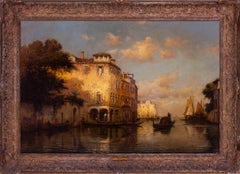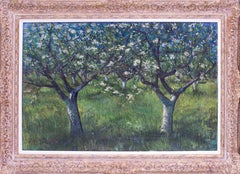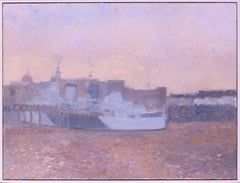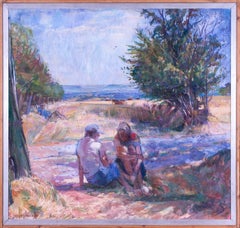Want more images or videos?
Request additional images or videos from the seller
1 of 12
Claude-Joseph VernetClaude-Joseph Vernet 18th century Old Master landscape, grand tour Italy
Price:$60,835.76
$71,896.81List Price
About the Item
- Creator:Claude-Joseph Vernet (1714 - 1789, French)
- Dimensions:Height: 22.25 in (56.52 cm)Width: 25.5 in (64.77 cm)Depth: 1 in (2.54 cm)
- Medium:
- Movement & Style:
- Period:
- Condition:Oil on canvas, relined. Paint surface in good order, recently cleaned and varnished (ask for photographs post restoration). In an expensive gilded frame.
- Gallery Location:Petworth, GB
- Reference Number:1stDibs: LU54038029892
About the Seller
4.9
Platinum Seller
Premium sellers with a 4.7+ rating and 24-hour response times
Established in 2010
1stDibs seller since 2017
272 sales on 1stDibs
Typical response time: 2 hours
Authenticity Guarantee
In the unlikely event there’s an issue with an item’s authenticity, contact us within 1 year for a full refund. DetailsMoney-Back Guarantee
If your item is not as described, is damaged in transit, or does not arrive, contact us within 7 days for a full refund. Details24-Hour Cancellation
You have a 24-hour grace period in which to reconsider your purchase, with no questions asked.Vetted Professional Sellers
Our world-class sellers must adhere to strict standards for service and quality, maintaining the integrity of our listings.Price-Match Guarantee
If you find that a seller listed the same item for a lower price elsewhere, we’ll match it.Trusted Global Delivery
Our best-in-class carrier network provides specialized shipping options worldwide, including custom delivery.You May Also Like
View of St. John’s Cathedral, Antigua
Located in New York, NY
Provenance:
Robert Hollberton, Antigua, ca. 1841
Private Collection, New York
The present painting depicts Old St. John’s Cathedral on the island of Antigua. The church was erected in the 1720s on the designs of the architect Robert Cullen. It measured 130 feet by 50 feet with north and south porches 23 x 20 ½ feet. The tower, 50 feet high with its cupola, was added in 1789. The church was elevated to the status of a cathedral, but disaster struck in the form of an earthquake that destroyed the building on 8 February 1843. A memorandum of that date relates the event:
“On Wednesday, 8th February, 1843, this island was visited by a most terrific and destructive earthquake. At twenty minutes before eleven o’clock in the forenoon, while the bell was ringing for prayers, and the venerable Robert Holberton was in the vestry-room, awaiting the arrival of persons to have their marriage solemnized, before the commencement of the morning service, the whole edifice, from one end to the other, was suddenly and violently agitated. Every one within the church, after the first shock, was compelled to escape for his life. The tower was rent from the top to the bottom; the north dial of the clock precipitated to the ground with a dreadful crash; the east parapet wall of the tower thrown upon the roof of the church; almost the whole of the north-west wall by the north gallery fell out in a mass; the north-east wall was protruded beyond the perpendicular; the altar-piece, the public monument erected to the memory of lord Lavington, and the private monuments, hearing the names of Kelsick, Warner, Otley, and Atkinson, fell down piecemeal inside; a large portion of the top of the east wall fell, and the whole of the south-east wall was precipitated into the churchyard, carrying along with it two of the cast-iron windows, while the other six remained projecting from the walls in which they had been originally inserted; a large pile of heavy cut stones and masses of brick fell down at the south and at the north doors; seven of the large frontpipes of the organ were thrown out by the violence of the shock, and many of the metal and wooden pipes within displaced; the massive basin of the font was tossed from the pedestal on which it rested, and pitched upon the pavement beneath uninjured. Thus, within the space of three minutes, this church was reduced to a pile of crumbling ruins; the walls that were left standing being rent in every part, the main roof only remaining sound, being supported by the hard wood pillars.”
The entrance from the southern side into the cathedral, which was erected in 1789, included two imposing statues, one of Saint John the Divine and the other of Saint John the Baptist in flowing robes. It is said that these statues were confiscated by the British Navy from the French ship HMS Temple in Martinique waters in 1756 during the Seven Years’ War and moved to the church. The statues are still in situ and can be seen today, much as they appeared in Bisbee’s painting, but with the new cathedral in the background (Fig. 1).
Little is known of the career of Ezra Bisbee. He was born in Sag Harbor, New York in 1808 and appears to have had a career as a political cartoonist and a printmaker. His handsome Portrait of President Andrew Jackson is dated 1833, and several political lithographs...
Category
19th Century Old Masters Landscape Paintings
Materials
Canvas, Oil
A Wolf
Located in New York, NY
Provenance:
The Marchesi Strozzi, Palazzo Strozzi, Florence
Sale, Christie’s, London, May 20, 1993, lot 315, as by Carl Borromaus Andreas Ruthart...
Category
17th Century Old Masters Animal Paintings
Materials
Canvas, Paper, Oil
Early oil depicting the Great Fire of London
Located in London, GB
The Great Fire of London in September 1666 was one of the greatest disasters in the city’s history. The City, with its wooden houses crowded together in narrow streets, was a natural fire risk, and predictions that London would burn down became a shocking reality. The fire began in a bakery in Pudding Lane, an area near the Thames teeming with warehouses and shops full of flammable materials, such as timber, oil, coal, pitch and turpentine. Inevitably the fire spread rapidly from this area into the City. Our painting depicts the impact of the fire on those who were caught in it and creates a very dramatic impression of what the fire was like. Closer inspection reveals a scene of chaos and panic with people running out of the gates. It shows Cripplegate in the north of the City, with St Giles without Cripplegate to its left, in flames (on the site of the present day Barbican). The painting probably represents the fire on the night of Tuesday 4 September, when four-fifths of the City was burning at once, including St Paul's Cathedral. Old St Paul’s can be seen to the right of the canvas, the medieval church with its thick stone walls, was considered a place of safety, but the building was covered in wooden scaffolding as it was in the midst of being restored by the then little known architect, Christopher Wren and caught fire. Our painting seems to depict a specific moment on the Tuesday night when the lead on St Paul’s caught fire and, as the diarist John Evelyn described: ‘the stones of Paul’s flew like grenades, the melting lead running down the streets in a stream and the very pavements glowing with the firey redness, so as no horse, nor man, was able to tread on them.’
Although the loss of life was minimal, some accounts record only sixteen perished, the magnitude of the property loss was shocking – some four hundred and thirty acres, about eighty per cent of the City proper was destroyed, including over thirteen thousand houses, eighty-nine churches, and fifty-two Guild Halls. Thousands were homeless and financially ruined. The Great Fire, and the subsequent fire of 1676, which destroyed over six hundred houses south of the Thames, changed the appearance of London forever. The one constructive outcome of the Great Fire was that the plague, which had devastated the population of London since 1665, diminished greatly, due to the mass death of the plague-carrying rats in the blaze.
The fire was widely reported in eyewitness accounts, newspapers, letters and diaries. Samuel Pepys recorded climbing the steeple of Barking Church from which he viewed the destroyed City: ‘the saddest sight of desolation that I ever saw.’ There was an official enquiry into the causes of the fire, petitions to the King and Lord Mayor to rebuild, new legislation and building Acts. Naturally, the fire became a dramatic and extremely popular subject for painters and engravers. A group of works relatively closely related to the present picture have been traditionally ascribed to Jan Griffier...
Category
17th Century Old Masters Landscape Paintings
Materials
Oil, Canvas
18th Century Galanti Scenes Van Limborch Rest Hunting Oil on Canvas Green Red
Located in Sanremo, IT
Pair of oval paintings measuring 66 x 89 cm without frame and 90 x 115 cm with coeval frame depicting two gallant moments during a rest from hunting by painter Hendrik Van Limborch (...
Category
1730s Old Masters Landscape Paintings
Materials
Canvas, Oil
$10,763
H 25.99 in W 35.04 in D 1.97 in
18th Century By Giustino Menescardi Ascent to Calvary Oil on Canvas
Located in Milano, Lombardia
Giustino Menescardi (Milan, Italy, c. 1720 - Venice, Italy, after 1779)
Title: Ascent of Calvary
Medium: Oil on canvas
Dimensions: without frame 47 x 36 cm - with frame 57 x 43 cm
Shaped and gilded wooden cassetta frame
Publications:
Bozzetti, modelletti, sketches: dalla collezione di Giorgio Baratti...
Category
Early 18th Century Old Masters Landscape Paintings
Materials
Cotton Canvas, Canvas, Oil
$12,246 Sale Price
22% Off
H 18.51 in W 14.18 in D 1.97 in
18th Century by Antonio Stom Architectural Capriccio Oil on Canvas_
By Antonio Stom
Located in Milano, Lombardia
Antonio Stom (Venice, Italy, c. 1688 - 1734)
Title: Architectural Capriccio
Medium: Oil on canvas
Dimensions: without frame 88 x 113 cm - with frame 106 x 132 cm
Carved, sculpted and...
Category
Early 18th Century Old Masters Landscape Paintings
Materials
Canvas, Oil, Cotton Canvas
$19,135 Sale Price
28% Off
H 34.65 in W 44.49 in D 1.97 in
18th Century by Francesco Zuccarelli Landscape with River and Waterfall
Located in Milano, Lombardia
Francesco Zuccarelli (Pitigliano, Italy, 1702 - Florence, Italy, 1788)
Title: Landscape with River and Waterfall
Medium: Oil on canvas
Dimensions: without frame 55 x 78.5 cm - with frame 70 x 93 cm
Expertise by Professor Giancarlo Sestieri
Publications: Giorgio Baratti Collezione. Selezione di opere d’arte antica (Giorgio Baratti Collection. Selection of ancient works of art), curated by Professor Giancarlo Sestieri with the participation of Professor Andrea Emiliani, Grafiche Veneziane, Venezia 2011, pp...
Category
18th Century Old Masters Landscape Paintings
Materials
Canvas, Oil
$79,699 Sale Price
20% Off
H 21.66 in W 30.91 in D 2.37 in
18th Century By Giovanni Domenico Gambone Pair of Capricci Oil on Canvas
Located in Milano, Lombardia
Giovanni Domenico Gambone (1720 - 1793)
Title: Pair of Capricci
Medium: Oil on canvas
Dimensions: without frame 85 x 112 cm - with frame 97 x 124 cm
The price is intended for the c...
Category
Mid-18th Century Old Masters Landscape Paintings
Materials
Oil, Canvas
$15,882 Sale Price
20% Off
H 33.47 in W 44.1 in D 1.97 in
17th Century by Felice Torelli Rachel Hiding the Idols Oil on Canvas
Located in Milano, Lombardia
Felice Torelli (Verona, Italy, 1667 - Bologna, Italy, 1748)
Title: Rachel Hiding the Idols
Medium: Oil on canvas
Dimensions: without frame 41 x 116 cm -...
Category
Late 17th Century Old Masters Landscape Paintings
Materials
Canvas, Oil, Cotton Canvas
$15,547 Sale Price
20% Off
H 20.67 in W 50.01 in D 1.97 in
18th Century by Giuseppe Pianca Shepherd with Goat and River Oil on Canvas
Located in Milano, Lombardia
Giuseppe Antonio Pianca (Agnona di Borgosesia, Italy, 1703 - Milan, Italy, 1762)
Title: Shepherd with Goat and River
Medium: Oil on canvas
Dimensions: without frame 49 x 57 cm - wit...
Category
18th Century Old Masters Landscape Paintings
Materials
Cotton Canvas, Oil, Canvas
$22,388 Sale Price
22% Off
H 19.3 in W 22.45 in D 1.97 in
More From This Seller
View AllGondolier on a Venetian backwater, oil on canvas, by Antoine Bouvard senior
By Antoine Bouvard (Marc Aldine)
Located in Petworth, West Sussex
Antoine Bouvard (French, 1882–1956)
Gondolier on a Venetian Backwater
Oil on canvas
Signed ‘Bouvard’ (lower left)
21.25 x 32 in. (54 x 81.5 cm)
In this tranquil Venetian scene, Anto...
Category
19th Century Academic Landscape Paintings
Materials
Canvas, Oil
1955 British oil painting of an apple orchard by John Gilbey Bowles, in green
Located in Petworth, West Sussex
A luminous early landscape by John Gilbey Bowles, The Apple Orchard captures two apple trees in delicate white blossom, rendered in a loose, impressionist manner. Soft green tones do...
Category
20th Century Impressionist Landscape Paintings
Materials
Canvas, Oil
Modern British oil on canvas of the warship HMS Belfast by Bernard Myers
Located in Petworth, West Sussex
Bernard Myers (British, 1925–2007)
HMS Belfast
Oil on canvas
30 x 39.75 in. (76.2 x 101 cm)
Provenance: From the estate of the artist
A luminous and contemplative painting by Britis...
Category
20th Century Modern Landscape Paintings
Materials
Canvas, Oil
Large oil painting of Edna and Daphne, South Downs, West Sussex 1977 John Bowles
Located in Petworth, West Sussex
John Gilbey Bowles (British, 1929 – 2011)
Edna and Daphne before the South Downs, 1977
Oil on canvas
Signed ‘J Bowles’ (lower left)
38.1/8 x 40.1/8 in. (96.7 x 102 cm.)
Notes: Daphne...
Category
20th Century Modern Landscape Paintings
Materials
Canvas, Oil
Modern British oil on canvas of Tower Bridge, London by Bernard Myers
Located in Petworth, West Sussex
Bernard Myers (British, 1925–2007)
Tower Bridge
Oil on canvas
23.75 x 29.875 in. (60.5 x 75.8 cm)
Provenance: From the estate of the artist
In Tower Bridge, Bernard Myers offers a n...
Category
20th Century Modern Landscape Paintings
Materials
Canvas, Oil
Large oil painting of a fox and hunter in the English countryside by John Bowles
Located in Petworth, West Sussex
John Gilbey Bowles (British, 1929 – 2011)
The challenge – fox and hunter
Oil on canvas
Signed ‘J Bowles’ (lower left)
38 x 38 in. (96.5 x 96.5 cm.)
John Gilbey Bowles, a distinguish...
Category
20th Century Modern Landscape Paintings
Materials
Canvas, Oil
Recently Viewed
View AllMore Ways To Browse
Vernet Claude Joseph
Grand Tour Oil Painting
Napoleonic Wars Painting
Nathan Hale
Niek Van Der Plas
Nighttime Oil Painting
Northwest Impressionist
Norwich School Paintings
Oil Painting Bahamas
Oil Painting Majorca
Old Beach Oil Painting
Original Oil Painting Canada
Paintings Of Birch Trees
Paintings Of Cotswold
Paintings Of Istanbul
Patrick Vale
Paul Albert Laurens Oil Paintings
Peter Rudolph



